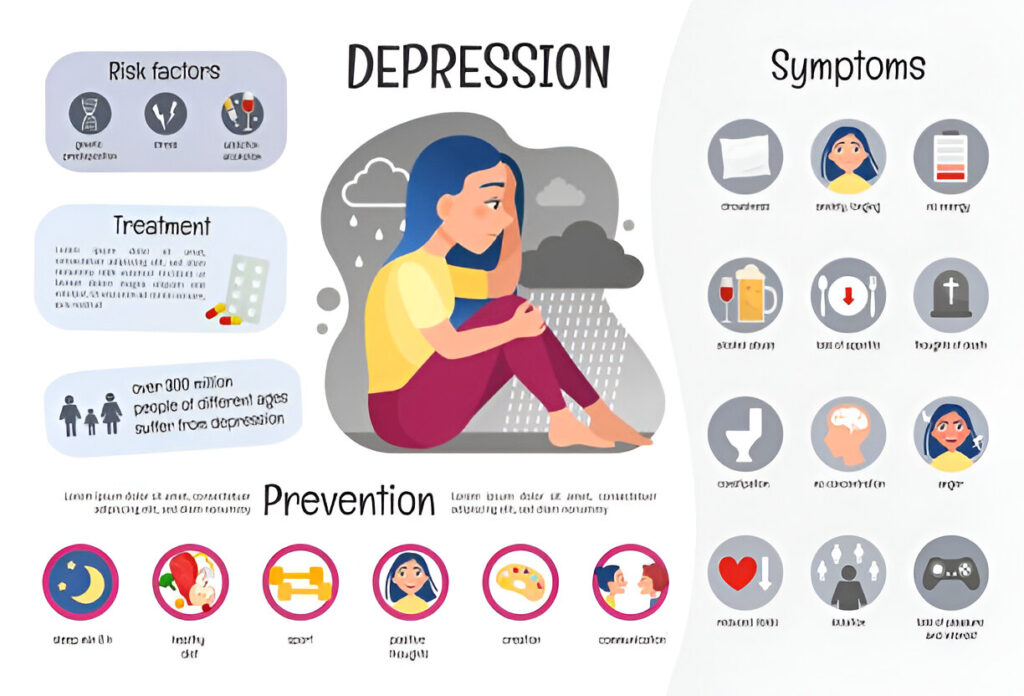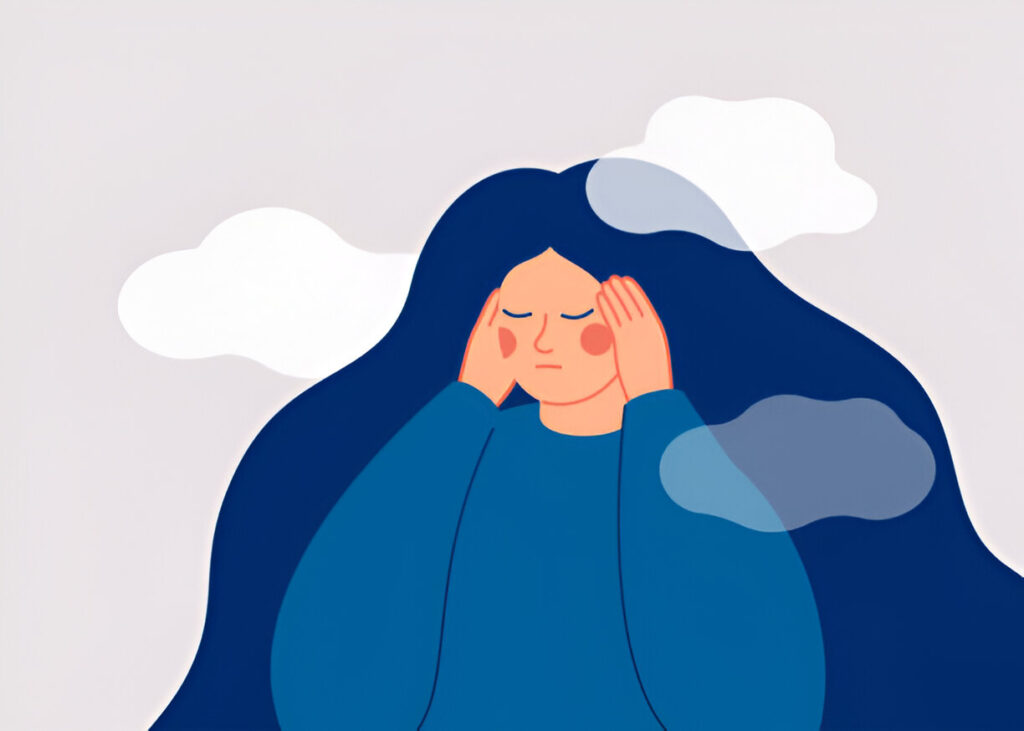Symptoms of depression and anxiety can be overwhelming, often creating a constant sense of fear, sadness, or hopelessness. Individuals may experience persistent sadness, excessive worry, irritability, or physical symptoms like fatigue and trouble sleeping.
These symptoms can interfere with daily life, making even simple tasks impossible. However, there are robust solutions to help manage and reduce the impact of these mental health challenges. The first step is recognizing the importance of seeking professional help, such as therapy or counseling, which can provide valuable coping tools.
Another solution is incorporating regular physical activity, which has been shown to improve mood and reduce anxiety by releasing endorphins. Mindfulness practices, including deep breathing and meditation, are also effective in calming the mind and creating a sense of peace in moments of overwhelm.

Building a strong support system of friends, family, or support groups can provide emotional relief and help individuals feel less isolated. Lastly, a consistent routine prioritizing sleep, nutrition, and self-care can help regulate mood and minimize symptoms. By adopting these five robust solutions, individuals can take control of their mental health and work towards a more balanced, peaceful life.
1. Break the Cycle and Regain Control of Your Life
Breaking the Cycle of Anxiety
Living with depression and anxiety can feel like a constant, unending cycle. One moment, you might feel slightly at ease, but then, out of nowhere, the weight of worry, fear, or sadness falls upon you once again. Over time, this cycle can take a serious toll on your mental and physical health.
The good news is that breaking free from this cycle and regaining control of your life is possible. By understanding the symptoms of depression and anxiety and implementing simple but powerful solutions, you can start your journey toward healing and regain a sense of peace and balance.
Understanding the Cycle
The first step in breaking the cycle of depression and anxiety is to recognize how they work together. Anxiety often leads to overthinking, which can trigger feelings of depression. In turn, depression can deepen your anxiety by making you feel helpless or hopeless.
Symptoms of depression and anxiety may include constant worrying, fatigue, irritability, loss of interest in things you once enjoyed, and physical symptoms like trouble sleeping or headaches. These symptoms can make it feel as if you’re stuck in a loop with no way out. However, understanding that these emotions are not permanent and that change is possible is key to taking back control.
Developing Awareness
Awareness is a powerful tool when it comes to breaking the cycle of depression and anxiety. It’s essential to recognize the specific moments and triggers that cause your mental health to spiral. Often, we push down our feelings, telling ourselves to “snap out of it,” but this only leads to more frustration and internal conflict.
By practicing mindfulness and becoming aware of your emotions as they arise, you can start to separate yourself from them. When you understand that you’re experiencing symptoms of depression and anxiety not defining yourself by them you regain a sense of power. Acknowledging what’s happening is the first step in managing your mental health.
Taking Small Steps
One of the most common pieces of advice given to those struggling with depression and anxiety is to “take small steps.” While it may sound too simplistic, it’s incredibly effective. When you’re overwhelmed, large tasks or goals can be impossible to achieve.
Instead of aiming for perfection or instant relief, focus on taking small, manageable daily steps. Whether getting out of bed, going for a short walk, or taking a few minutes to meditate, these small actions gradually build momentum. Over time, as you notice the positive impact of these steps, you’ll feel more in control and less dominated by your anxiety and depression.
Building Healthy Habits
To break the cycle of depression and anxiety, creating healthy, consistent habits is crucial. Your daily routines impact your mood, energy, and overall mental health. When you’re dealing with the symptoms of depression and anxiety, it’s easy to slip into unhealthy habits like poor diet, lack of sleep, or avoiding physical activity.
These habits, in turn, can make the cycle even worse. Instead, try to build habits that nurture your mental and physical well-being. Start with something small, like getting enough sleep, eating balanced meals, and incorporating exercise into your daily routine.
Even simple activities like stretching or taking deep breaths can promote relaxation and help reduce anxiety. As you focus on these positive habits, you’ll feel more empowered and in control of your well-being.
Seeking Support
Sometimes, breaking the cycle of depression and anxiety requires seeking outside support. It can be challenging to manage your symptoms independently, and there’s no shame in reaching out for help. Therapy, support groups, or talking to a trusted friend or family member can make a big difference.
Speaking with a therapist who specializes in depression and anxiety can give you tools and techniques to navigate difficult emotions. Remember, breaking free from this cycle is not about doing it alone; it’s about connecting with others who can help you through your journey.
Regaining Control
Ultimately, the path to breaking the cycle of depression and anxiety is about regaining control of your life. By practicing awareness, taking small steps, building healthy habits, and seeking support, you can begin to take charge of your mental health.
The symptoms of depression and anxiety might never disappear entirely, but you’ll develop the resilience and tools to manage them effectively. Every small victory, whether a day without overwhelming anxiety or a moment of joy amidst sadness, brings you closer to breaking free from the cycle. Take each day as an opportunity to reclaim your life and find the peace you deserve.
By embracing these solutions, you’ll not only break the cycle but also learn to thrive in a way that allows you to live fully without being weighed down by the constant presence of depression and anxiety.
2. Simple, Effective Strategies to Overcome Overwhelm
Identify the Root Cause
When you’re overwhelmed, it’s easy to feel like everything is crashing down at once. But often, the feeling of overwhelm comes from a combination of different factors.
The first step to overcoming overwhelm is to identify what’s triggering it. Is it a looming deadline, a personal conflict, or perhaps the ongoing symptoms of depression and anxiety that make everything seem more complicated than it should be?
Once you recognize the root cause, it’s easier to break the situation down and tackle each part individually. This shift in focus allows you to manage tasks more effectively without feeling like you’re drowning in them.
Prioritize and Simplify
Focusing on what matters most is challenging when your mind is clouded with overwhelming thoughts. A key strategy for overcoming overwhelm is to prioritize your tasks. Make a list of everything you need to do and determine what is most urgent or essential.
Instead of trying to do everything simultaneously, simplify your focus by tackling one task at a time. Small wins lead to a sense of accomplishment and motivation, which can help you push through overload.
Remember, you don’t have to do it all at once breaking things down into smaller, manageable chunks can significantly reduce the stress and pressure.
Practice Deep Breathing
Overwhelm often triggers a physical response a racing heart, shallow breathing, and a general sense of tension. Practicing deep breathing is a simple yet highly effective strategy to overcome this. When you feel overwhelmed, take a moment to close your eyes and focus on your breath.
Slowly inhale through your nose for a count of four, hold for a count of four, and then exhale through your mouth for a count of four. This practice helps to calm your nervous system, reduce anxiety, and bring your focus back to the present moment. Incorporating deep breathing into your daily routine can make it easier to manage overwhelming moments as they arise.
Set Boundaries
When you’re overwhelmed by the demands of life, it’s easy to say yes to everything and everyone to please others or avoid conflict. However, this only feeds into the cycle of stress and exhaustion. One of the most effective strategies for overcoming overwhelm is learning to set clear boundaries.
This means saying no to tasks, commitments, or people that drain your energy, especially when your mental health is at stake. Setting boundaries helps you conserve your energy for the things that truly matter and allows you to focus on what’s essential without becoming bogged down by unnecessary obligations.

Seek Support and Share the Load
Another key to overcoming overwhelm is recognizing that you don’t have to carry the weight of everything alone. Seeking support from friends, family, or a therapist can lighten the emotional load.
Sharing your struggles with someone who understands can provide much needed perspective, and often, just talking things out can make the situation more manageable.
Support doesn’t always mean having someone fix your problems it’s about having someone listen, empathize, and offer guidance when needed. Sometimes, the simple act of voicing your concerns can help you see the way forward more clearly.
Practice Self-Compassion
Finally, overcoming overwhelmed isn’t just about taking action it’s also about being kind to yourself. If you’re experiencing symptoms of depression and anxiety, the pressure to perform and “get everything done” can be incredibly intense.
But it’s important to acknowledge that you’re doing your best practice self compassion by recognizing that it’s okay not to have everything figured out. Allow yourself time to rest, recharge, and heal when needed. Being gentle with yourself is not a sign of weakness; it’s a necessary part of self-care and emotional resilience.
Reframe Your Mindset
How we think about overwhelm plays a significant role in our experience. When you feel overwhelmed, it’s easy to slip into a mindset of helplessness or defeat. However, reframing your thoughts can make a huge difference.
Instead of viewing challenges as insurmountable, try to see them as opportunities for growth. Each small step you take toward managing your overwhelm completing a task or simply taking a break is progress. Embrace this mindset shift, and you’ll feel less weighed down by the pressures around you.
Move Forward at Your Pace
Remember that overcoming overwhelm isn’t a race. It’s about making progress in a way that works for you. Whether you’re dealing with the symptoms of depression and anxiety or simply trying to balance multiple responsibilities, the key is to move forward at your own pace.
Trust that by using these simple and effective strategies, you will gradually regain control of your life, one step at a time. Overwhelm may be a part of life, but it doesn’t have to define your experience. You can break free and find your balance again with patience, perseverance, and the right tools.
By recognizing the causes of your overwhelm, simplifying your approach, and prioritizing your mental health, you can regain control and clarity, no matter how daunting the challenges may seem.
3. Proven Techniques for Managing Stress and Finding Peace
Understanding Stress
Before diving into techniques for managing stress, it’s essential to understand how it affects both the mind and body. Stress triggers our brain’s “fight or flight” response, releasing hormones like adrenaline and cortisol that prepare us to respond to danger.
While this response is helpful in acute situations, chronic stress especially when compounded by the symptoms of depression and anxiety can have long-term adverse effects on our health.
These effects can include insomnia, high blood pressure, digestive issues, and emotional exhaustion. Recognizing the signs of stress early on is the first step toward mitigating its impact.
Breathing Exercises for Calm
Deep breathing is one of the most straightforward yet powerful techniques for managing stress. Stress can cause shallow, rapid breathing, which in turn exacerbates feelings of anxiety and tension.
By consciously slowing down your breath, you can activate the body’s relaxation response, lowering cortisol levels and calming your nervous system.
Try the 4-7-8 breathing technique: inhale for four counts, hold for seven, and exhale for eight counts. Repeat this for several minutes, and notice how your body relaxes. Practicing deep breathing regularly can help you feel more in control of your reactions to stress and improve your overall sense of peace.
Mindfulness and Meditation
Mindfulness is the practice of staying fully present in the moment without judgment. It’s a proven technique for managing stress because it helps you detach from overwhelming thoughts and worries. Constantly thinking about the past or future makes it easy to become stressed and anxious.
Mindfulness allows you to focus on the here and now, returning your attention to your breath, surroundings, or bodily sensations. Meditation, often used with mindfulness, is another effective technique for managing stress.
Even just a few minutes of meditation a day can help lower stress, reduce symptoms of depression and anxiety, and cultivate a greater sense of peace. Apps like Headspace or Calm can guide you through short, focused sessions if you’re new to meditation.
Physical Activity for Stress Relief
Exercise is one of the most effective stress relief tools available. When you engage in physical activity, your brain releases endorphins natural mood boosting chemicals that can help alleviate stress and improve your mood.
Whether going for a jog, doing yoga, or even taking a brisk walk, moving your body helps reduce the tension accumulated during stressful moments. Regular exercise also helps regulate the symptoms of depression and anxiety, improving sleep and energy levels.
Even small amounts of daily physical activity can significantly impact how you manage stress and find peace in your day-to-day life.
Time Management and Setting Boundaries
One of the most significant contributors to stress is feeling overwhelmed by too many responsibilities. Poor time management and lack of boundaries often lead to burnout, especially when juggling work, family, and personal demands.
To reduce stress, start by organizing your day and prioritizing tasks based on their importance and urgency. Don’t hesitate to delegate when necessary, and learn to say no when you feel stretched too thin.
Setting clear boundaries around work, social commitments, and personal time ensures you’re not constantly giving to others at the expense of your well-being. Over time, better time management and clear boundaries help foster a sense of control and reduce overwhelming feelings.

Engage in Creative Outlets
Engaging in creative activities is an excellent way to manage stress and bring peace. Whether painting, writing, gardening, or playing music, these activities allow you to focus your energy on something positive and fulfilling.
Creative expression will let you let go of stressful thoughts and immerse yourself in the present moment. This can be incredibly therapeutic, especially for individuals dealing with anxiety or depression.
Creating something, no matter how small, can help redirect your focus, calm your mind, and bring a sense of accomplishment and peace.
Social Connections and Support
Another powerful technique for managing stress is leaning on your social network. Humans are social creatures, and maintaining positive relationships with friends, family, or a support group can significantly reduce stress and promote emotional well-being.
Talking about your stressors with someone you trust can help you process your emotions and feel less isolated. Social support helps buffer against the adverse effects of stress and provides a sense of connection and belonging.
Whether it’s a quick chat with a friend, a family gathering, or a support group meeting, nurturing these relationships is essential to managing stress and finding peace.
Sleep and Restorative Practices
It’s challenging to manage stress when you’re running on empty. Sleep is crucial for both physical and mental well-being, and insufficient rest can exacerbate the symptoms of depression, anxiety, and stress.
A lack of sleep impairs cognitive function, increases irritability, and makes it harder to cope with stress effectively. Practicing good sleep hygiene such as sticking to a consistent sleep schedule, limiting caffeine intake, and creating a relaxing bedtime routine can help you get the restful sleep your body and mind need.
Additionally, restorative practices like naps or simply lying down for a few minutes of stillness during the day can help you recharge and lower stress levels.
Positive Self Talk and Perspective
How you talk to yourself plays a crucial role in managing stress. Negative self talk such as telling yourself that you’re incapable or that things will never get better only fuels anxiety and stress. A simple but effective stress management technique is reframing your thoughts and practicing positive self talk.
Stop and replace negative statements with encouraging, realistic ones when you are overwhelmed. Remind yourself that you are doing your best and that taking things one step at a time is okay. Shifting your mindset to one of self-compassion can alleviate stress and help you approach challenges with greater calm and clarity.
Gratitude Practice
Finally, cultivating gratitude can significantly improve your ability to manage stress and find peace. When you’re feeling overwhelmed, it’s easy to focus on what’s going wrong, but shifting your focus to what’s going right can change your perspective.
Each day, take a few moments to reflect on things you’re grateful for your health, a supportive friend, or a beautiful sunset. Studies show that practicing gratitude regularly can reduce stress, increase happiness, and promote a more peaceful mindset. By training your brain to focus on the positive, you naturally create space for peace to flourish.
4. Easy to Implement Steps for Reducing Anxiety and Boosting Mood
Managing Anxiety and Mood
Anxiety and mood swings are everyday struggles for many people, often leaving you feeling overwhelmed, restless, and disconnected from your sense of peace.
Whether you’re dealing with the everyday stresses of life or the symptoms of depression and anxiety, finding practical ways to reduce anxiety and improve your mood can make a world of difference.
Luckily, easy to implement steps can help you regain balance and start feeling betterw ithout needing to make drastic changes. These simple strategies can be woven into your routine, creating a positive ripple effect on your mental well-being.
Understand Your Triggers
The first step to reducing anxiety and boosting your mood is understanding what triggers these feelings. Anxiety often arises from specific situations, thoughts, or even physical sensations.
It’s essential to become more aware of the moments you feel the most anxious or down and try to identify patterns.
Are there certain people, tasks, or environments that tend to increase your anxiety? Do you notice a drop in your mood at particular times of the day or in response to specific stressors?
By identifying these triggers, you can take the necessary steps to minimize them or prepare yourself to respond more resiliently when they arise.
Breathe Your Way to Calm
When anxiety strikes, your body goes into a fight-or-flight response, which can make your heart race and your mind spiral. Deep breathing exercises are one of the simplest and most effective ways to calm down.
This technique helps activate the body’s relaxation response, slowing your heart rate and reducing feelings of anxiety.
Try deep, diaphragmatic breathing by inhaling slowly through your nose for a count of four, holding for a count of four, and exhaling through your mouth for a count of four.
Repeat this process for several minutes until you feel your anxiety begin to ease. You’ll find that deep breathing reduces physical tension and helps you stay grounded in the present moment, which can significantly boost your mood.

Engage in Physical Activity
Physical movement is one of the most powerful tools for reducing anxiety and improving your mood. When you exercise, your body releases endorphins, natural mood lifters.
Even a short walk, yoga session, or a few minutes of stretching can significantly reduce anxiety symptoms and help you feel more centered.
Regular physical activity also helps manage the symptoms of depression, providing a natural chemical boost to your brain. If you’re feeling anxious or low, try incorporating some form of movement into your day even if it’s just a quick 10-minute workout.
Over time, the cumulative effect of consistent physical activity can profoundly impact your overall well-being.
Limit Stimulants
If you’re struggling with anxiety or mood swings, your diet and lifestyle choices may play a role. Certain substances, like caffeine, nicotine, and sugar, can exacerbate anxiety by stimulating the nervous system and creating spikes and crashes in your energy levels.
If you’re prone to anxiety, it may be helpful to limit or eliminate these stimulants from your routine. Opting for herbal teas like chamomile or drinking plenty of water can help keep you hydrated and calm.
Balancing your nutrition by eating regular meals with whole foods can also support stable energy levels and a more even mood throughout the day.
Prioritize Sleep
Sleep is often the first thing to suffer when anxiety takes hold. However, insufficient sleep can significantly worsen both anxiety and mood disorders. Lack of rest disrupts your ability to manage stress, increases irritability, and decreases your ability to cope with life’s challenges.
Prioritizing good sleep hygiene is essential for reducing anxiety and boosting your mood. Try to maintain a consistent sleep schedule, create a calming bedtime routine, and avoid screens at least an hour before bed.
If you’re struggling with sleep, relaxation techniques like deep breathing, meditation, or even reading a calming book before bed can help prepare your body for restful sleep.
Practice Mindfulness
Mindfulness is staying present and fully engaged in the moment without judgment. When you’re anxious or low, your mind often spirals into negative thought patterns about the past or future. Mindfulness allows you to step back from these thoughts, bringing your focus to the here and now.
You can practice mindfulness by focusing on your breath, paying attention to your surroundings, or engaging in mindful activities like eating, walking, or even washing dishes. Over time, mindfulness helps break the cycle of anxiety and negative thinking, improving both your mental clarity and mood.
Create a Gratitude Practice
Focusing on gratitude is a potent tool for boosting mood and reducing anxiety. Feeling down or anxious makes it easy to get caught up in negative thoughts about what’s not going well in your life. However, shifting your focus to what you’re thankful for helps rewire your brain toward positivity.
Try starting or ending each day by writing down three things you’re grateful for. They don’t have to be big things sometimes, they’re small moments of joy, like a hot cup of tea or a kind interaction with a friend, that make the most difference.
Regular gratitude practice has been shown to reduce anxiety and depression while also promoting a more positive and peaceful outlook on life.

Stay Connected with Others
Isolation often worsens the symptoms of both anxiety and depression. Maintaining strong social connections is one of the easiest ways to boost your mood.
Whether talking to a friend, spending time with family, or joining a community group, connecting with others helps reduce loneliness and provides a support system.
Socializing doesn’t always have to mean big gatherings sometimes, just a brief phone call or a walk with a friend can work wonders for your mental health. By staying connected, you remind yourself that you’re not alone, which can alleviate anxiety and provide comfort during difficult times.
Set Realistic Expectations
One of the reasons anxiety can feel so overwhelming is the pressure we place on ourselves to perform at a high level, regardless of how we’re feeling. Setting unrealistic expectations or trying to meet impossible standards can increase stress and anxiety, leaving you feeling inadequate.
To reduce anxiety and improve your mood, it’s essential to set realistic, achievable goals for yourself. Break down large tasks into smaller, manageable steps, and be kind to yourself if things don’t go as planned. Celebrate your progress, no matter how small, and recognize that perfection is not the goal progress is.
Seek Professional Help When Needed
While these steps can be efficient, there are times when the symptoms of anxiety or depression may require more than self-care techniques. If you’re finding it difficult to manage anxiety or mood swings on your own, seeking professional help is a crucial step.
A therapist or counselor can help you understand the underlying causes of your anxiety and provide you with additional tools and strategies to cope effectively. Therapy, combined with other lifestyle changes, can give you the support you need to manage your mental health and feel more balanced.
4. Easy to Implement Steps for Reducing Anxiety and Boosting Mood
Various studies demonstrate that anxiety and mood fluctuations become prevalent issues affecting people, which subsequently generate feelings of being overloaded while experiencing restlessness and loss of emotional stability.
Taking easy-to-adopt steps to control anxiety and improve your mood transforms the quality of your daily life, no matter if you face everyday life struggles or depression symptoms.
Simple adjustments enable people to recover their equilibrium while creating positive changes in their mood status. You can integrate these basic methods into your daily activities, improving your mental health.
Understand Your Triggers
The initial process toward cutting anxiety levels and lifting your mood starts with discovering what occasions activate these emotions. Understandably, anxiety comes from particular moment-to-moment situations as well as individual thoughts and bodily feelings.
Becoming alert to your most anxious and downtimes enables you to discover recurring stressful situations. Which specific elements cause your anxiety to rise, such as particular individuals, specific jobs, or select environments? Please pay attention to your mood changes because they occasionally happen during specific times or after particularly stressful events.
Identifying these trigger points enables you to implement steps that limit their occurrence while developing resistance when they appear.
Breathe Your Way to Calm
Your body activates the fight or flight system during anxiety, bringing about heart racing and mental spirals. Practicing deep breathing serves as a fundamental and proven method to achieve calmness. Through this approach, your body can relax, which leads to a reduced heart rate and fewer anxious feelings.
Begin diaphragmatic breathing with nose inhales lasting four counts followed by four counts of breath holding, after which you should exhale through your mouth for four counts. Several minutes of repeating this exercise technique will result in diminished anxiety symptoms.
Deep breathing works to ease the physical strain and centers your mind during the present, which together leads to significant mood elevation.
Engage in Physical Activity
Physical exercise stands as a highly effective strategy to decrease anxiety symptoms while enhancing your emotional state. Exercise triggers endorphins to come out of your body, making them natural mood enhancing substances.
Anxiety symptoms become less intense, and you will feel more grounded following any activity involving walking, yoga practice, or simple stretching sessions. Physical exercise manages depression symptoms while providing your brain with natural chemical increases.
When you experience anxiety or low moods, make time for any physical movement throughout your day, regardless of its brief nature. The combined result of regular physical exercise produces remarkable improvements to your personal health status.
Limit Stimulants
Your current eating behavior, together with daily habits, could contribute to anxiety and mood swings, so it is essential to consider these factors.
The stimulants, including caffeine and, nicotine, and sugar ingredients, produce nervous system activation then create unstable patterns of energy, which worsen anxiety symptoms.
Stimulant use should be minimized or stopped entirely because it intensifies anxiety symptoms in individuals who suffer from this condition. Chamomile herbal tea or large amounts of water will help maintain hydration and mental calmness.
A regulated diet of complete foods during each meal helps maintain steady energy levels, producing a calmer mood during the day.
Prioritize Sleep
Anxiety tends to attack sleep duration as its initial target of destruction. Insufficient sleep causes significant deterioration of both anxiety and mood disorders.
Insufficient rest negatively affects stress management abilities and causes increased irritability, reducing the capacity to deal with emotional challenges.
Good sleep practices stand as a primary requirement to control anxiety while improving mood levels. Create a peaceful bedtime practice and establish a regular sleep schedule and screen limitations beginning one hour before bedtime.
To achieve better sleep, start your evenings with deep breathing exercises, meditation, or reading peaceful books since these activities prepare your body for restful slumber.

Practice Mindfulness
Dealing with the present moment through complete involvement is what mindfulness entails while refraining from making assessments.
During anxiety and low mood, your thoughts naturally move toward unfavorable recollections from the past or anticipated concerns of the future.
Through mindfulness, you distance yourself from disregarded thoughts by concentrating on your current experience.
Practicing mindfulness begins by breathing mindfully, observing surroundings, and performing attentive activities ranging from eating to walking.
By practicing mindfulness, your psychological patterns will change, and your mental state will improve alongside your emotional frame of mind.
Create a Gratitude Practice
The practice of gratitude provides a highly effective method that enhances your emotional state while decreasing feelings of anxiety. The anxious state of mind makes it simple to dwell on all the negative aspects of your life.
Thanking yourself for all positive things in life allows your brain to establish new positive neural pathways. Your daily routine should begin with ending it by writing down three objects that make you thankful.
Even insignificant pleasures such as tea enjoyment or heartfelt friend exchanges deliver maximum impact among all the things you can be grateful for.
The routine practice of gratitude demonstrates its ability to lower depression alongside anxiety and develop a calm and optimistic attitude toward life.
Stay Connected with Others
Escaping social contact usually makes anxiety symptoms worse, together with depressive conditions. Living connected with people provides one of the speediest routes to mood improvement.
Human connection through friend conversations, family gatherings, or group participation leads to decreased loneliness and obtains emotional support for individuals.
The key to social interaction for mental health improvement does not require significant social events since even short phone calls with friends and walks together produce positive effects.
Keeping in touch with people lets you feel less alone, thus reducing your anxiety level during challenging times.
Set Realistic Expectations
Anxiety becomes overwhelming because people push themselves to succeed at high levels despite their emotional state. Rigid and non-realistic goal setting and attempting unfeasible tasks will escalate your anxiety, along with creating feelings of inadequacy.
Your mood will become better, and your anxiety levels will decrease if you choose reasonable, achievable goals.
Make significant undertakings easier to handle by dividing them into smaller, workable steps, besides giving yourself compassion when your attempt at something fails.
Your triumphs should always be acknowledged, even if they seem tiny, because actual progress is the objective.
Seek Professional Help When Needed
Some cases need medical support beyond basic self-care actions when dealing with depression symptoms or anxiety problems. Every person should seek help from professionals when personal treatment methods fail to control anxiety or mood swings.
Therapists, along with counselors, assist people in discovering anxiety’s root causes before helping develop practical coping tools for better management.
Combining therapy with lifestyle modifications will provide you with essential aid that enables better control of your mental health standing.
How to reduce depression?
To avoid depression, you need to exercise regularly, develop a balanced diet, and sleep well. To cope with stress, practice mindfulness, meditation, or deep-breathing exercises.
Lean on supportive friends and family members and reach out for professional help when necessary. Having hobbies and setting small, attainable goals can also improve mental well-being.
Conclusion
Eliminating anxiety and enhancing mood happen through straightforward approaches in daily life activities. You can start experiencing more stability and serenity through simple steps, including learning about what creates anxiety, deep breathing, physical exercise, proper rest periods, and staying connected with friends.
Your mental well-being can benefit substantially from all changes, large and small, that you make along the path to improvement. A commitment to basic practices will guide you toward emotional peace and positive perspectives accompanied by better emotional control.
<script type="application/ld+json">
{
"@context": "https://schema.org",
"@type": "Article",
"mainEntityOfPage": {
"@type": "WebPage",
"@id": "https://skyhealthnews.com/symptoms-of-depression-and-anxiety/"
},
"headline": "Symptoms of Depression and Anxiety",
"description": "Symptoms of depression and anxiety can be overwhelming, often creating a constant sense of fear, sadness, or hopelessness.",
"image": "https://skyhealthnews.com/wp-content/uploads/2025/02/Symptoms-of-Depression-and-Anxiety-4-1024x683.jpg",
"author": {
"@type": "Person",
"name": "Farhad",
"url": "https://skyhealthnews.com/author/farhad"
},
"publisher": {
"@type": "Organization",
"name": "",
"logo": {
"@type": "ImageObject",
"url": ""
}
},
"datePublished": "2025-02-02"
}
</script>









